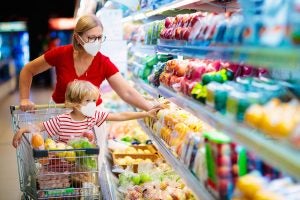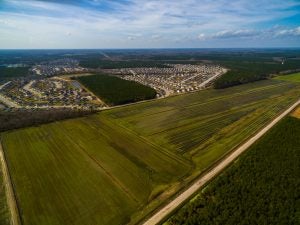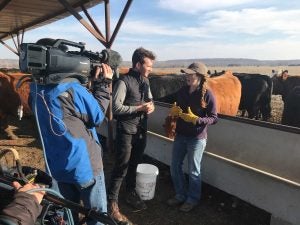This article was a collaboration between longtime AGDAILY contributor Tim Durham, who has a farm in Long Island, New York, and Dirk Voeste of Limburgherhof, Germany.
If we could peer into ag’s crystal ball, what would it portend? Multiple challenges beckon, potentially fueling the perfect storm. In these dangerous times of food insecurity, the biblical Four Horsemen of the Apocalypse have assumed new titles. They’re the four “C’s” of climate, crisis, conflict, and cost.
Yet Murphy’s Law guarantees that anything that can go wrong, will go wrong — and at the worst possible time. Additional horsemen — consumption and cities — further vex us under a cloud of anxious uncertainty.
Fortunately, this is tempered by good news: three “C” modifiers — the Anti-Horsemen — that offer reasons for optimism.
Let’s start with the threats, as farmers struggle to feed a planet of more than 8 billion people; truly the most daunting job on earth.
- Climate: The great-granddaddy of them all, this is the most pressing, catch-all threat. The effects are just beginning to materialize, with potentially cataclysmic long-term consequences. Farmers will feel them profoundly, as rainfall patterns shift, droughts and floods increase, and pests and diseases intrude into new ranges. Most notably, these changes will depress yields. A study from 2017 warns that each degree-Celsius rise in the global mean temperature will depress wheat harvests by 6 percent, rice by 3.2 percent, corn by 7.4 percent, and soybeans by 3.1 percent.
- Crisis: Climate change occurs over decades, but crisis can strike swiftly and unexpectedly. COVID-19 (and associated lockdowns) is a perfect example of a sudden and major disruption that exposed the frailties of global supply chains. Restrictions on travel and commerce led to labor and food shortages. According to one expert, the pandemic wiped out two decades of food security gains. The nature of the next crisis is anyone’s guess. It could be a major volcanic eruption, a geomagnetic storm, or a new viral contender. The only certainty is that another crisis is on deck.

- Conflict: Russia’s invasion of Ukraine has revealed how even war can reverberate worldwide. In the wake of the pandemic, the United Nations estimated that those suffering from severe food insecurity would jump by nearly 50 million. As the devastating conflict grinds into its second year, other potential conflicts loom in Africa, Asia, and the Middle East, threatening to escalate an already tense situation. Although a trade deal allowed Ukraine to ship some grain, it was only a fraction of the former export levels. The consequences are unpredictable, but many experts fear social unrest and waves of refugee migrations.
- Cost: Farmers have acutely felt the effects of global inflation as input prices soar. The cost of fertilizer alone has doubled or tripled. Farmers have no choice but to pass on these expenses to consumers, who in turn absorb the markup in the grocery aisle. In addition to COVID and the Ukraine conflict, growing global demand for biofuels was strained due to drought –tightening wheat and corn stocks. Moreover, unpredictable container and personnel availability are also affecting logistics costs. For example, Handelsblatt reports (article in German) that the cost of shipping a ton of grain on the Rhine River increased fivefold in August 2022 due to low water levels, perhaps a consequence of climate change.
There are two additional “horsemen” to consider in this already-troubling equation.
- Consumption: In a world beset by hunger, we waste an extraordinary amount of food — about 40 percent in the US — callously scraped off plates into caloric purgatory. This suggests that although farmers can produce a plentiful bounty, we fail to direct it appropriately. Indeed, we produce enough raw calories to feed every man, woman, and child, but irregularities in distribution (undeveloped infrastructure or kleptocratic regimes wielding food as a weapon) are confounding. All the more reason to empower individuals with homegrown food security. Moreover, keeping pace with population growth (at today’s productivity levels), would necessitate additional farmland, thieving precious habitat. According to the IPBES, biodiversity loss is also an ever-present threat to the global food supply, potentially endangering the wellbeing of at least 3.2 billion individuals by 2050. How? By stifling essential ecosystem services like water purification, nutrient cycling, and inducing conflict and mass migrations to cities (see below).
- Cities: We’re “consuming” productive land at a clip of 23 hectares every minute. By 2050, more than 60 precent of the world population will reside in urban centers — the new majority. This represents a crucial demographic pivot — most will be denizens of the urban jungle; with 100 cities of size comparable to Metro Mexico City. As cities grow, they gobble up land for housing, resources, and infrastructure, often burying productive farmland underfoot. Local ecosystems are strained to their breaking point, lacking the capacity to accommodate the footprint of urban megalopolises.

The “C’s” of uncertainty represent the grand challenges of our era; a gauntlet farmers are eager to navigate. All intersect, blurring the challenge boundaries between them. Yet they converge into one wicked problem: food insecurity. While rightfully focusing on urgency, the “C” model may connote calamity among Joe and Jane Q. Public. As such, it’s crucial to weave in some additional “C’s” as opportunity modifiers. Collaboration, choice, and communication are restorative — practical, scalable, and impactful — and an appropriate solution-centric bookend.
- Collaboration: The continued support and vigor of agricultural universities, experiment stations, and Extension — laboratories of discovery, innovation, and outreach — along with symbiotic partners in industry, is critical. Moreover, private and public partnerships preserve farmland through the purchase of development rights (PDR) programs. These mechanisms allow farmers to keep the title to their property, but also guarantee that it will remain in production agriculture — even as cities encroach — and families transfer ownership to a new generation. Additionally, new mentorship programs pair land-rich and cash-poor veteran farmers with younger heir apparents who are keen to be the new gatekeepers of food security.
- Choice: Farmers are uniquely positioned at the environmental, economic, and societal nexus. They crave choice — choice of practice and philosophy that align with their circumstances and market (organic, conventional, biointensive, regenerative, climate resilient), and technology (chemical, biological, digital, bio-engineered) — all backed by science and free from ideology. When farmers have access to these tools, they flourish.
- Communication: Farmers have strong credibility as storytellers. In this digital age of direct appeals, they can share their knowledge and describe needs to anyone with a social media account. In the conversation about food security and stewardship, they have a powerful voice — and they’ve never had a better chance to wield it.

Farmers simply desire the right toolbox to dynamically react to the changing environment. Politicians, for their part, need to provide a pragmatic and future-proof framework that spurs innovation. As a society, we have a responsibility to understand the urgency of the “C’s” and act accordingly — to think globally and act locally. If we’re wise about collaboration, choice, and communication, we’ll rise to the challenges and subdue the horsemen that plague the world with uncertainty.
Tim Durham is a fifth-generation farmer, growing leafy greens, root crops and herbs on Long Island, New York. Tim is also an Associate Professor of Crop Science at Ferrum College, Virginia and is a member of the Global Farmer Network.
Dirk Voeste is a former Senior Vice President for Regulatory, Sustainability & Public Affairs, Agricultural Solutions for BASF in Limburgerhof, Germany. He was in this role at the writing of this article.


